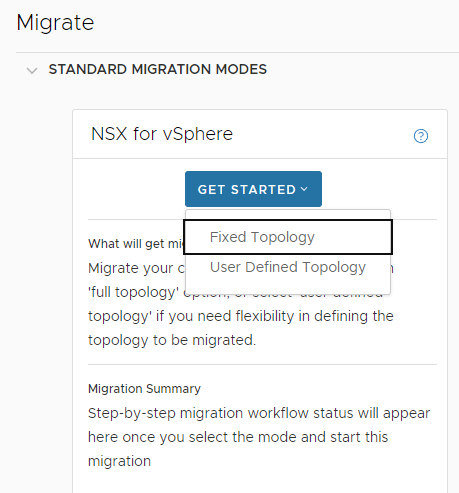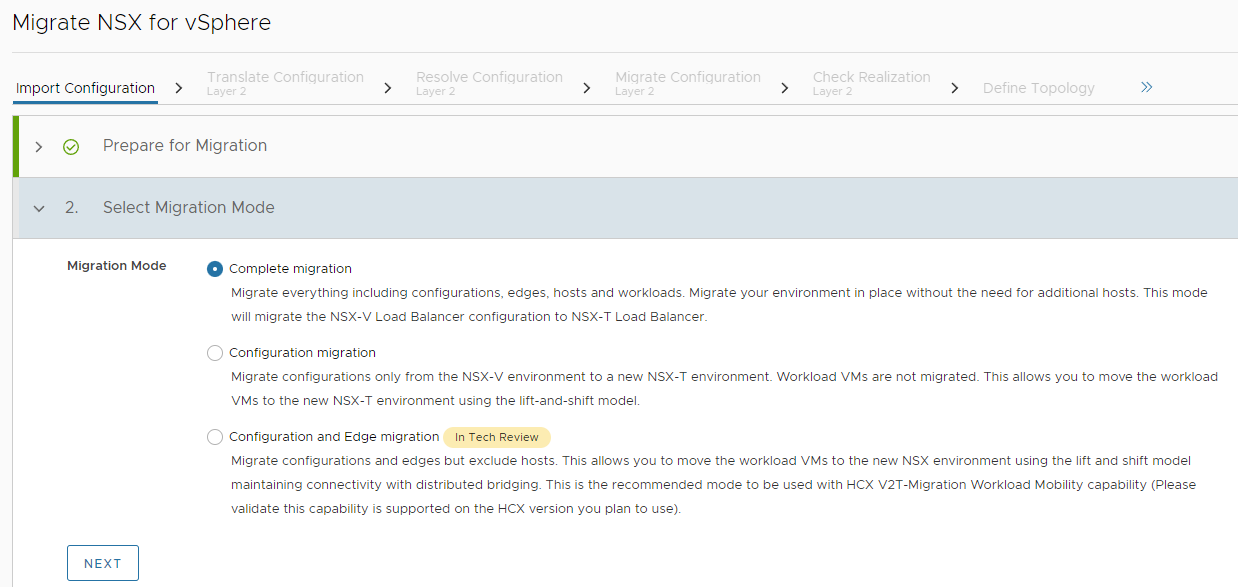There are multiple ways you can migrate NSX-V to NSX-T.
- Migrate NSX for vSphere
- Fixed Topology
Fixed topology migration is limited to the topologies supported in Fixed Topologies Supported for End-to-End Migration.
- User-defined Topology
User-defined topologies allow migrating any topology from NSX-V. You create the layer-3 topology on NSX-T and maps the NSX-v Edge Services Gateways (ESGs) and Distributed Logical Routers (DLRs) to NSX-T tier-0 or tier-1 gateways.
There are two modes available when you choose user-defined topology:- Complete Migration
- Configuration Migration
- Configuration and Edge Migration (available in NSX-T 3.2.2 as a tech preview feature)
The folowing screen shows the migration modes that are available when you select NSX for vSphere:

The folowing screen shows the migration modes that are available when you select User-defined Topology:

The following table shows the type of migration for each mode:
Mode Migration Type Fixed Topology End-to-end User-Defined Topology + Complete Migration End-to-end User-Defined Topology + Configuration Migration Lift-and-shift User-defined Topology + Configuration and Edge Migration Lift-and-shift. Supports HCX for workload migration. An end-to-end migration will migrate the whole NSX-V environment. A lift-and-shift migration will migrate configurations only, such as firewall or load balancer. After the configurations are migrated, you migrate workload VMs using vMotion and a layer-2 bridge between the NSX-V and NSX-T environments. You can also do a lift-and-shift migration using the advanced migration mode "Migrate Distributed Firewall (DFW)".
- Fixed Topology
- Migrate vSphere Networking
In this mode, you migrate vSphere Distributed Switch (VDS) 6.5.0 and 6.6.0 to NSX Virtual Distributed Switch (N-VDS). For more information, see Migrating vSphere Networking.
- Migrate NSX for vSphere with vRealize Automation
Similar to the "Migrate NSX for vSphere" mode, you can select Fixed Topology or User Defined Topology. Before migrating a user-defined topology, you must check the vRealize Automation documentation to ensure that your version of vRealize Automation supports the migration of a user-defined topology. For more information about this migration mode, see Migrating NSX-V with vRealize Automation - Fixed Topology or Migrating NSX-V with vRealize Automation - User-Defined Topology.
- Migrate Edge Cutover
In this mode, north-south traffic is migrated from NSX-V to NSX-T. For more information, see Migrating North-South Traffic to NSX-T Edges Using Edge Cutover.
- Migrate Distributed Firewall (DFW)
In this mode, you do a lift-and-shift migration of the distributed firewall. For more information, see Migrating Distributed Firewall Configuration.
- Migrate Distributed Firewall, Host and Workload
In this mode, you do an in-place migration of the distributed firewall, hosts, and workload VMs. For more information, see In-Place Migration of Specific Parts of NSX-V.
- During the migration or before removing NSX-V, do not perform any lifecycle operation, or restart NSX-V Manager or vCenter server. Lifecycle operations include, but are not limited to, upgrading or patching vCenter server, NSX-V Manager or NSX-T Data Center, renewing certificates, or changing passwords.
- NSX-V should be removed as soon as possible after the migration has completed successfully.
- If you need to perform lifecycle operations, you must do so before the start of the migration.
Migrating a User-Defined Topology
- Complete Migration - This will migrate everything (configurations, Edge Services Gateways, Distributed Logical Routers, hosts and workloads) in place without the need for additional hosts. The NSX-V load balancer will be migrated to an NSX-T load balancer.
- Configuration Migration - This will migrate configurations only. After the migration, you can migrate the workload VMs using vMotion. The NSX-V load balancer will be migrated to NSX-T Advanced Load Balancer (ALB). This is the only way to migrate the NSX-V load balancer to ALB.
- Configuration and Edge Migration (available in NSX-T 3.2.2 as a tech preview feature) - This will migrate configurations, bridge the NSX-V logical switches to their corresponding NSX-T segments, and migrate Edge nodes for north-south traffic cutover. You can migrate workload VMs after the Edge nodes are migrated. This mode supports the HCX V2T Migration Workload Mobility capability.
Migrating a Cross-vCenter Environment to NSX Federation
Starting with NSX-T 3.2.1, you can migrate an NSX-V cross-vCenter environment to an NSX Federation environment in NSX-T. You must perform the migration from the Global Manager, choose the Migrate NSX for vSphere mode and select User Defined Topology. You can then choose either Complete Migration or Configuration Migration. Migrating a cross-vCenter environment to NSX Federation is not supported in any other migration mode. Also, in NSX-T 3.2.1, migrating a cross-vCenter environment to NSX Federation does not support migrating the NSX-V load balancer. Starting with NSX-T 3.2.2, The NSX-V load balancer will be migrated to an NSX-T load balancer.